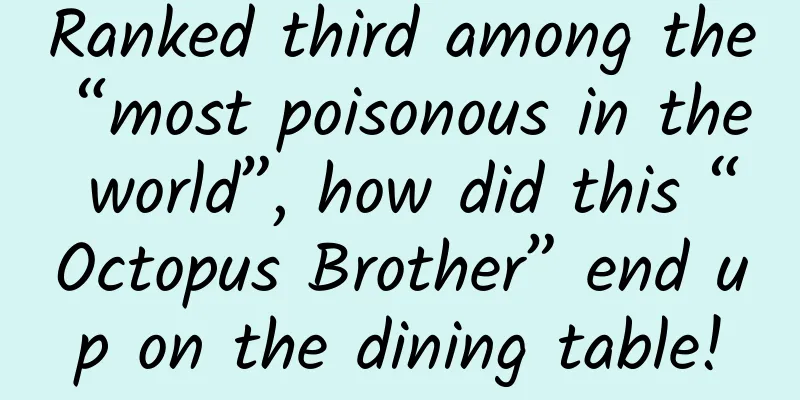Ranked third among the “most poisonous in the world”, how did this “Octopus Brother” end up on the dining table!

|
Netizens found blue-ringed octopus in hot pot restaurant dishes Source: Weibo “Can I eat it?” "Eating everything will only harm you!" As the concept of popular science becomes more and more popular, many friends will play such jokes when faced with new species, adding a lot of humorous and funny elements to the seemingly serious and boring popular science work. However, what no one expected is that such a common "joke" can sometimes really affect the life safety of the questioner! Just a few days ago, a Weibo user found a creature that looked like a blue-ringed octopus in a hot pot restaurant dish. It was later confirmed that it was indeed a highly poisonous blue-ringed octopus. Later, another user found that the seafood he bought was also mixed with inedible blue-ringed octopus... Netizens claim that the boxed baby octopuses they bought were mixed with highly poisonous blue-ringed octopuses Source: Weibo For a while, "how to save life at the dinner table" became a hot topic among netizens. So, how terrible is this blue-ringed octopus? What are the consequences if it is eaten by mistake? Today, the editor will share with you to find out. 1 How to distinguish a blue-ringed octopus from a regular octopus "This octopus also has rings on its body. Does that mean it can't be eaten?" As soon as the news about the blue-ringed octopus came out, many friends lost their "trust" in the octopus on the table and began to suspect that they had also sold the highly poisonous blue-ringed octopus. In fact, most of the photos posted by netizens are of "short octopus", which is one of the most common edible octopus species in my country, and those circular patterns suspected to be "blue rings" are precisely the identification characteristics of the short octopus. There are tiny octopuses, poisonous and non-toxic ones. How should we distinguish them in our daily lives? The short-ringed octopus (Octopus ocellatus) that we eat daily belongs to the Octopus genus of the Octopidae family, while the blue-ringed octopus (Hapalochlaen maculosa) belongs to the Hapalochlaen genus of the Octopidae family. There are currently four known species: the crescent octopus (H. lunulata), the striped octopus (H. fasciata), also known as (blue-ringed octopus), the spotted octopus (H. maculosa) and the Nierstraszi octopus (H. nierstraszi), of which the Nierstraszi octopus is an uncertain species. Crescent Leopard Octopus Source: reef2reef.com Striped Leopard Octopus Source: reeflifesurvey.com Spotted leopard octopus Source: Wikipedia Source: reeflex.net The blue-ringed octopus is native to the waters off the west coast of the Pacific Ocean, and is usually found in the Pacific Ocean between Japan and Australia. In recent years, as the climate warms, the distribution of the blue-ringed octopus has tended to expand or move northward. The most common blue-ringed octopus in China's tropical and subtropical waters is Octopus leopardus (blue-ringed octopus). The short octopus has a characteristic ring pattern under the eyespot, but is usually golden yellow. Source: naturepl.com The blue-ringed octopus is generally not large, with a wingspan of no more than 15 cm, and a body size of a golf ball. Like other octopuses, the blue-ringed octopus' body is made entirely of soft tissue except for the beak, and has four pairs of arms on its head, with suction cups of varying sizes on the arms. In addition, the blue-ringed octopus' body is covered with blue or blue-black circles, spots or stripes, and when threatened, it will emit a flashing blue fluorescence, just like wearing leopard print clothing. As for those octopuses with only one or two circles on their bodies, it is basically certain that they are not blue-ringed octopuses. 2 How poisonous is Squidward? Although the blue-ringed octopus is not large in size, it is recognized as one of the most dangerous creatures on earth. It ranks third among the ten most poisonous animals in the world as selected by the American magazine "World Wildlife". Its toxicity is even far greater than that of the king cobra that everyone is familiar with. How did the tiny octopus receive this "honor"? Studies have shown that blue-ringed octopuses carry a series of toxic substances in their bodies, including tetrodotoxin, serotonin, hyaluronidase, etc., among which tetrodotoxin is the most dangerous. Pathogenic mechanism of tetrodotoxin Source: alchetron.com Tetrodotoxin is one of the most toxic neurotoxins found in nature, with a toxicity more than 1,000 times that of sodium cyanide. It can block sodium ion channels on the surface of muscle and nerve cell membranes, thereby blocking action potentials, inhibiting the conduction of excitation between nerves and muscles, causing muscle paralysis, and ultimately leading to the victim's death from cardiopulmonary arrest. Not only that, the chemical and thermal properties of pufferfish toxin are very stable, and it cannot be decomposed by ordinary heating or cooking. At present, no antidote for pufferfish toxin has been found, and there is a lack of effective rescue measures after poisoning. Once poisoned, the patient's vital signs can only be maintained through symptomatic treatment and general life support. The toxin of the blue-ringed octopus is mainly found in its saliva, and is also partially distributed in its muscles, mantle of internal organs, and ink. When the blue-ringed octopus attacks, it injects the venom into its prey by biting it, causing it to quickly lose consciousness. However, when the octopus is eaten, its salivary glands and ink are often cleaned out, leaving only the muscles with a lower toxin content, and the toxin ingested through the digestive tract often does not reach the minimum lethal dose for humans. Despite this, there are still several records of people being poisoned by eating blue-ringed octopus abroad. In 2010, a person in Taiwan also experienced nausea, vomiting, dizziness, weakness, numbness and other symptoms after eating blue-ringed octopus, and was rescued from life-threatening danger. 3 How to complete "Table Survival Game" In addition to blue-ringed octopus, there are many other "traps" on our dining tables that can easily trap us if we are not careful. There are many types of crabs, such as the upright clean crab, the patterned clean crab, and the bronze cooked crab. Because they often eat poisonous food and can accumulate toxins in the food, they may cause poisoning if eaten by mistake. Among them, the upright clean crab is often mistaken for the brown crab (edible zodiac crab) because of its similar appearance, but the latter is a delicacy with rich fat and meat. Patterned Clean Crab Source: picture-worl.org Bronze Cast Cooked Crab Source: flickriver.com Honest and Clean Crab Source: naturalamediterraneo.com Brown crab Source: fiskerforum.com In addition, many poisonous plants and animals, such as Datura fruit and okra, Gelsemium elegans and honeysuckle, horse chestnut and Chinese chestnut, are similar to common foods in daily life and are eaten by people every year, which may even cause death. Conus snails, wild mushrooms, and many other foods that look "harmless" are actually highly toxic. Once eaten by mistake, it may lead to a "village feast". Here, I want to say that the significance of popular science is not just to broaden our horizons, it can even save our lives at critical moments. In addition, the best way to avoid poisoning is to try to avoid eating foods whose types, properties, and cooking methods are unknown. For those friends who want to try anything strange, I just want to say: Don't eat it! |
<<: Body? Consciousness? Which one is the real me?
>>: Why can't we have blue hair?
Recommend
Review the feature upgrades and innovations of each generation of iPhone
Preface Since Apple released the first iPhone in ...
Baidu PPC position click-through rate
Recently, clients often ask me what to do if Baid...
How to do Metaverse Marketing?
62 million yuan in 40 minutes. This is the feedba...
Speculate on some trends in content marketing in 2017!
Some time ago, the Content Marketing Institute (C...
Would you buy LeTV phone?
The situation of the domestic mobile phone indust...
A complete set of low-cost customer acquisition methodology
If a business is not growing, it is declining. Gr...
List of "Science" Rumors in May 2023: Can "mouth-sealing patches" cure mouth breathing? Can a person be infected with COVID-19 up to 8 times?
The list of "scientific" rumors for May...
Advertising | Analysis of the mobile advertising market in Q3 2020
Important holidays are concentrated in Q3, which ...
The expensive "ruby", can we achieve cherry freedom this year?
Review expert: Wang Kang, Director of the Science...
3 ways to write “resonant copy”
Suppose now, you write a copy for a product calle...
Online APP and mini program new user traffic and conversion sharing
Today we will talk about platform content, user f...
Are autonomous vehicles generally more reliable than human drivers? | Technology Weekly
Compiled by Zhou Shuyi and Wang Xiang In most sce...
How do you monetize your product? Here are 3 channels to help you sort out
As dividends disappear and capital returns to rat...
After two years of struggle, the paper is finally published: How to overcome topological defects in quantum simulators?
After two years of fighting wits with reviewers, ...
Xiaohongshu Enterprise Account Complete Operation and Promotion Plan
This article will explain the significance of Xia...









